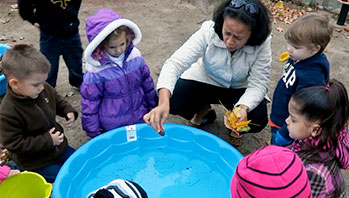- camera
- objects of different textures (e.g., balls of different textures, small wheels, tire, spools, etc.)
- farther
- faster
- ramp
- roll
- surface
- texture
MA Standards:
LanguageL.PK.MA.6: Use words and phrases acquired through conversations, listening to books read aloud, activities, and play.
MA Draft STE Standards:
Physical Sciences/Motion and Stability; Forces and Interaction/PS2.A: Plan and carry out investigations of the behaviors of moving things.
Physical Sciences/Motion and Stability; Forces and Interaction/PS2.B: Using evidence, discuss ideas about what is making something move the way it does and how some movements can be controlled. [Cause and Effect, Stability and Change]
Head Start Outcomes:
Logic and Reasoning/Reasoning and Problem Solving: Recognizes cause and effect relationships.
Science Knowledge/Scientific Skills and Method: Uses senses and tools, including technology, to gather information, investigate materials, and observe processes and relationships.
Science Knowledge/Scientific Skills and Method: Uses senses and tools, including technology, to gather information, investigate materials, and observe processes and relationships.
Science Knowledge/Scientific Skills and Method: Observes and discusses common properties, differences, and comparisons among objects.
PreK Learning Guidelines:
English Language Arts/Language 2: Participate actively in discussions, listen to the ideas of others, and ask and answer relevant questions.
Science and Technology/Living Things and Their Environment 15: Use their senses of sight, hearing, touch, smell, and taste to explore their environment using sensory vocabulary.
Science and Technology/Physical Sciences 19: Explore, describe, and compare the properties of liquids and solids found in children's daily environment.
Science and Technology/Physical Sciences 21: Explore and describe various actions that can change an object’s motion such as pulling, pushing, twisting, rolling, and throwing.
Explore Together (outdoors): Ramps with Different Surfaces

© Commonwealth of Massachusetts, Department of Early Education and Care. All rights reserved.
STEM Key Concepts: The motion and speed of a rolling or sliding object is affected by the texture of the object and the texture of the surface on which it is rolling or sliding
ELA Focus Skills: Compare and Contrast, Speaking and Listening, Vocabulary
Educator Prep: Before doing the activity, think of an outdoor area to take children to explore different inclined surfaces of different textures, such as a grassy hill, a playground slide, a sand hill in a sandbox. If you do not have access to an area with various inclined planes, create a few using different surface textures (e.g., sand, wood, imitation grass, carpet, cardboard, etc.) When outdoors, ask children questions such as, Which surface would be best for racing cars? Why do you think that is?
Take children outdoors to compare how objects roll on ramps that have different surfaces. First, investigate areas that may have a number of inclined planes. Ask children, “Do you see anything that looks like a ramp?” Review with children what a ramp is and have them find ramps in the area.
Have children freely explore rolling objects down ramps with different textures and compare what happens when objects roll down the ramps. As children explore, take notes or pictures about their observations. Watch and listen as children explore so you can engage them with questions such as,
- What do you think will happen if you sent the ball down the grassy hill?
- Which object do you think would travel fastest down the slide?
- Why do you think the rubber ball rolled farther down the ramp with the concrete surface than the ramp with the rocky surface?
- What do you think will happen if you put a bumpy ball and a smooth ball on the grassy hill? Which would roll down the hill faster?
Reflect and Share
Once inside, have the photos and notes available so children can refer to them while sharing their observations. Encourage them to use words to describe the texture of the balls and the texture of the ramp surfaces. Ask questions such as,
- What types of surfaces did most of the balls roll down?
- Why do you think the rubber ball rolled farther down the ramp with the concrete surface than the one with the rocky surface?
- Why do you think the wheel did not roll down the ramp with the bumpy texture?
- How did you make the beach ball roll down the ramp with the sandy surface?
Take It Further: Bring cardboard, towels, and other materials outside to change the surface texture of a ramp. Ask children to predict what will happen if they change the surface of a ramp. For example, place a piece of cardboard on the grass and ask, How does the cardboard change the way the spool rolls down the hill?
